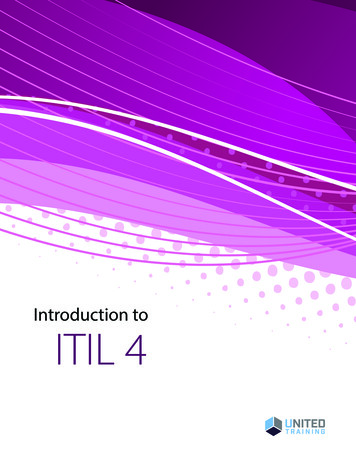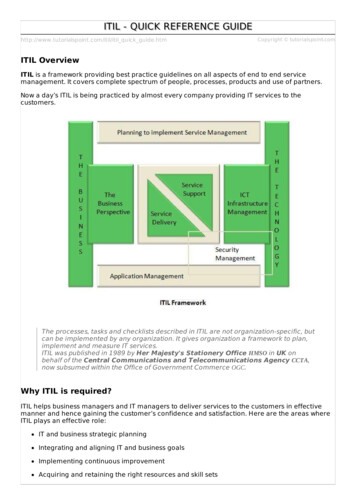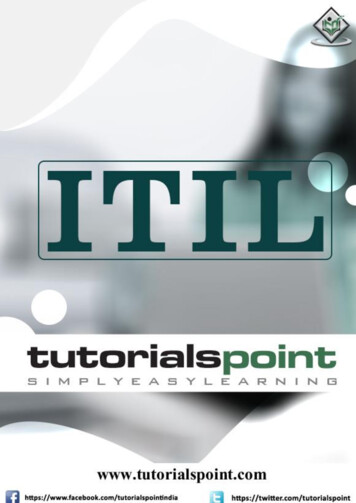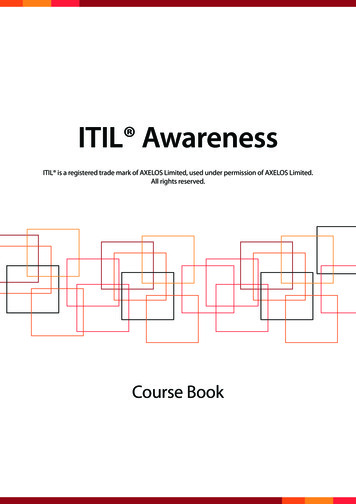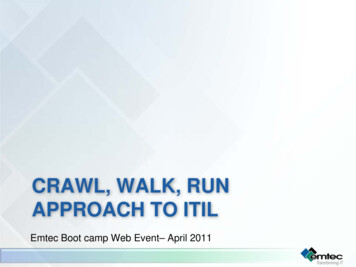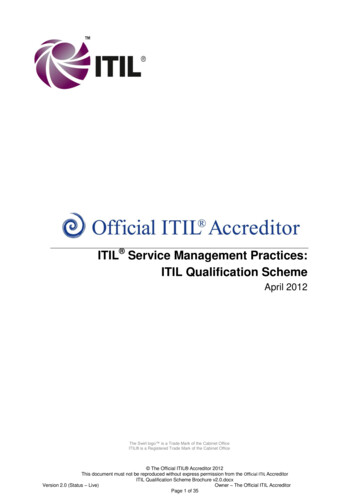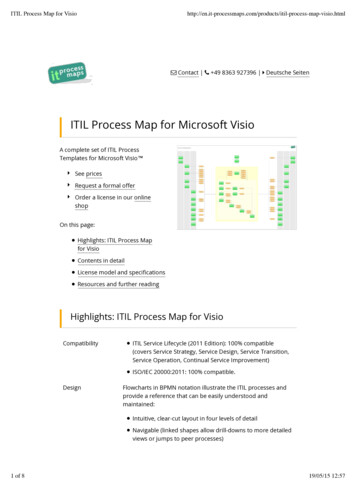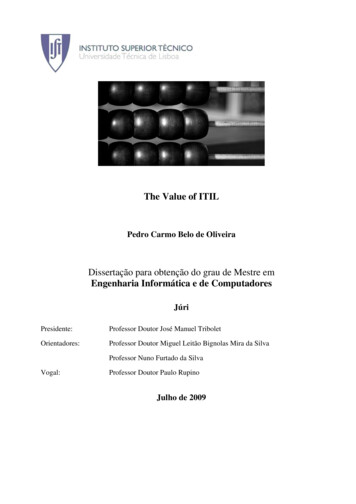
Transcription
The Value of ITILPedro Carmo Belo de OliveiraDissertação para obtenção do grau de Mestre emEngenharia Informática e de ComputadoresJúriPresidente:Professor Doutor José Manuel TriboletOrientadores:Professor Doutor Miguel Leitão Bignolas Mira da SilvaProfessor Nuno Furtado da SilvaVogal:Professor Doutor Paulo RupinoJulho de 2009
AcknowledgementsI’d like to show gratitude to a great deal of people who helped me get ahead of all the obstacles thatappeared during the last year.First and foremost, I offer my sincerest gratitude to my supervisor, Professor Miguel Mira da Silva,who has supported me throughout the development of my thesis with his guidance, vision,encouragement, understanding and knowledge whilst giving me enough room to be creative andexpress my own ideas.I would like to thank my co-supervisor, Eng. Nuno Furtado da Silva, for the assistance provided at alllevels of this research work and for taking time to guide me and provide me with useful insights. And, Iwould also like to thank Ana Paula Arsénio for the moral support she gave me in all phases of thisresearch work.I thank my family for supporting me throughout all my studies at university, and for the love they gaveme since I was born. It is to them that I dedicate this work.Finally, my gratitude goes to all my friends for providing me with cheerful as well as leisure moments,for patiently listening to my endless discussions about everything and nothing, and for the incessantsupport.I
AbstractAs World economy lingers it is increasingly more important to justify any investment so that availablecorporate funds are spent wisely. However, estimating the value of ITIL investments is not an easy task,which means that most CIOs do not invest in large-scale ITIL projects as much as it would be desirable.Instead, CIOs prefer to embark on quick win implementations (e.g. solely implement the incidentmanagement process). For this reason, it is necessary to create an ITIL Value Estimator. This estimatoris based on an estimation process that quantifies the project’s total cost, along with each process’benefits. The outcome of the ITIL Value Estimator is a Monte Carlo simulation whose result providesCIOs with a justification of the value of large-scale ITIL implementations, which can be used to gain theupper hand during the decision-making process.KeywordsValue of ITIL, estimator, metrics, risk analyses, cost-benefit analysis, KPIs.II
ResumoA crise económica mundial é cada vez mais premente, requerendo uma maior e mais detalhadajustificação de qualquer tipo de investimento. No entanto, estimar o ROI de implementações ITIL não étrivial, o que geralmente faz com que a maioria dos CIOs não invistam tanto em ITIL quanto seriadesejável. Consequentemente os CIOs tendem assim a optar por "quick wins" (por exemplo, apenas agestão de incidentes) em vez de implementações ITIL mais abrangentes. Por esta razão, é necessáriocriar um modelo de avaliação de implementações ITIL que permite quantificar os custos e osbenefícios de cada processo. O modelo baseia-se numa análise de sensibilidade, nomeadamentenuma simulação de Monte Carlo, cujo resultado final pode ajudar os CIOs a justificarem grandesprojectos ITIL aos conselhos de administração.Palavras-chaveValor do ITIL, estimador, métricas, análises de risco, análises custo-benefício, KPIs.III
Table of ContentsAcknowledgements.IAbstract .IIKeywords .IIResumo.IIIPalavras-chave .IIITable of Contents . IVList of Tables. VIList of Figures . VIIAcronyms and Abbreviations. VIII1. Introduction. 11.1 IT Selection . 21.2 Managing IT with ITIL v3 . 21.3 Problem Summary . 31.4 Proposal Summary . 41.5 Research Methodology . 41.6 Thesis Structure. 51.7 Related Publications. 52. Problem . 63. Related Work. 83.1 Investment Analyses . 83.1.1 Cost benefit analyses . 93.1.2 Risk analyses . 163.2 IT Investment Analyses . 173.2.1 Benefits Management . 183.2.2 Val IT . 203.3 Conclusion. 214. Proposal . 234.1 Context. 234.2 Assumptions . 234.3 Use Cases . 244.3.1 ITIL Maturity Survey Request. 244.3.2 ITIL Value Estimation Request. 254.4 Estimation Process Overview . 254.5 Estimation Process Description. 264.5.1 Benefits quantification process. 294.5.2 Costs quantification process . 294.5.3 Structure . 29IV
5. Implementation . 315.1 Prototype . 315.1.1 Requirements . 315.1.2 Architecture . 315.1.3 Development Process . 345.1.4 Graphical Interface . 355.1.5 AddIns Required. 395.1.6 Benefits Quantification Synopsis. 395.2 Evaluation Methodology . 405.2.1 Evaluation methodology for one process . 405.2.2 Evaluation methodology for multiple processes. 405.2.3 Requirements evaluation. 405.3 Action . 425.3.1 Common data . 425.3.2 Data used in the incident management process simulation. 435.3.3 Data used in the simulation with multiple processes. 455.4 Results . 465.4.1 Incident management process simulation. 465.4.2 Simulation with multiple processes . 525.4.3 Requirements results . 546. Evaluation . 556.1 Incident Management Process Simulation. 556.2 Simulation with Multiple Processes. 556.3 Requirements Evaluation. 566.4 Estimation Process Re-factorization . 567. Conclusion . 587.1 Future Work . 58References . 60V
List of TablesTable 1. Total Retail IT Spending, 2006-2011 (Millions of Dollars) [35]. 1Table 2. Comparison between financial metrics. 15Table 3. Comparison between investment evaluation approaches. 21Table 4. TdP’s general data. . 43Table 5. KPIs’ values. 44Table 6. Other variables’ values. 44Table 7. Investment analysis. . 46Table 8. Percentages from total benefits. 47Table 9. Risk influence. . 48Table 10. Correlations effect on the ROI Monte Carlo simulation. 49Table 11. Investment analysis. . 49Table 12. Percentages from total benefits. 50Table 13. Risk influence. . 51Table 14. Correlations effect on the ROI Monte Carlo simulation. 52Table 15. Correlations influence. 53VI
List of FiguresFig. 1. Project evaluation request. 2Fig. 2. ITIL v3 core. 3Fig. 3. Action research cycle [49]. . 4Fig. 4. Most significant barriers to ITIL adoption [10]. . 6Fig. 5. Graphical representation of correlations [74]. . 17Fig. 6. Benefits management project duration [33]. . 18Fig. 7. A process model for benefits management [33]. 19Fig. 8. Val IT domains. 20Fig. 9. ITIL maturity survey (including ITIL value estimation) request. 24Fig. 10. ITIL value estimation request. . 25Fig. 11. ITIL value estimation process. 28Fig. 12. Benefits quantification sub-process. 29Fig. 13. Cost quantification sub-process. . 29Fig. 14. Estimator’s structure in more detail. . 30Fig. 15. Architecture layered overview. . 32Fig. 16. Presentation layer. 32Fig. 17. Application logic layer. 33Fig. 18. Use relations between layers. . 34Fig. 19. Modified “action research” cycle. 34Fig. 20. Snapshot of the ITIL Value Estimator presentation sheet. 35Fig. 21. KPIs list overview. . 36Fig. 22. Incident management process’ benefits quantification. . 37Fig. 23. Investment analysis sheet. . 38Fig. 24. Monte Carlo simulation. 39Fig. 25. Cumulative benefits. . 47Fig. 26. ROI Monte Carlo simulation frequency. . 48Fig. 27. Cumulative benefits. . 50Fig. 28. ROI Monte Carlo simulation frequency. . 51Fig. 29. ROI Monte Carlo simulation frequency without correlations. . 52Fig. 30. ROI Monte Carlo simulation frequency with correlations. . 53Fig. 31. Re-factorized version of the ITIL value estimation process. . 57VII
Acronyms and AbbreviationsITILInformation Technology Infrastructure LibraryITInformation TechnologyISInformation SystemsCIOChief Information OfficerCEOChief Executive OfficerCFOChief Financial OfficerROIReturn On InvestmentDCFDiscount Cash FlowNPVNet Present ValueIRRInternal Rate of ReturnPBPPayBack PeriodEVAEconomic Value AddedKPIKey Process IndicatorTCOTotal Cost of OwnershipTBOTotal Benefit of OwnershipVIII
1. Introduction“Economy does not lie in sparing money, but in spending it wisely.”- Thomas Henry HuxleyToday’s competitive and turbulent economy forces organizations to struggle in order to remaincompetitive. Organizations can only grow by cutting costs as well as optimizing resources. Having thisin mind, a growing number of organizations has become increasingly dependent on IT to manage andgrow their businesses [1].A typical five-leg office chair is a good analogy to understand how organizations are structured thesedays. Each leg symbolizes a business function within the organization – for example: sales, marketing,manufacturing, product development and human resources. And, representing the chair’s spinal columnis the IT department which links and integrates the information that drives the business [17], [21].If all the wheels (business functions) are aligned, as a result of having a common direction (strategy),then all of them will roll towards the same pathway (business goal). However, this wheel synchrony isonly possible because the chair’s column (IT department) supports the chair (organization) byconnecting all the wheels. This simple analogy pictures the fact that organizations are intrinsicallydependent on IT.In the past, this IT dependency meant a growing IT budget, as shown in table 1, despite the fact thatthere was no evidence if IT investments would bring benefits to the organization [3]. This tendency isstill valid nowadays as approximately 500 billion are wasted on IT every year (e.g. failed projects,discarded technology), and the IT investment per employee keeps rising [2], [6]. However,disproportionate budgets are no longer allowed by the executive board, as CIO must justify their ITbudget, and must prove that IT projects are indeed necessary for the organization to maintain itscompetitive level [5], [70].Table 1. Total Retail IT Spending, 2006-2011 (Millions of Dollars) [35].Area200620072008200920102011IT ting3.7584.0994.3924.6935.0005.328IT lopment and cess l83.58891.17598.38496.392115.147124.6461
1.1 IT SelectionThere are several ways of selecting projects these days, but only three common practices areexplained here [18]. In the first, the administrative board, without the presence of the CIO, isresponsible for analyzing investments, making the CIO a powerless actor in the decision-makingprocess. Typically, administrative boards use a financial perspective. Therefore, it is essential for theCIO to understand key financial concepts so as to create well structured business cases, which is adocument that explains why a project should be chosen (see figure 1) [4].Fig. 1. Project evaluation request.In the second, the CIO is part of the administrative board, and tries to convince his/her peers thathis/her IT investment creates value [5]. The CIO may not be the only “technology champion” in theboard, as other executives might see technology as a core asset of the business [17]. Even though thisseems to be a good option, according to a 2005 research, CIOs are board members in only 8 percent ofGLOBAL Fortune 500 firms [19].The third and last common practice described here is for the CIO to discuss IT investments directlywith the CEO. In fact, statistics show that if this is the case, true alignment between business and IT willbe reached [18], [24].Nevertheless, CIOs who have negotiation skills are able to understand the power division in theboard, pinpoint who has decision rights and who is accountable in the decision-making process, andthen successfully use relationships with key stakeholders to influence their stance [18], [20].Another essential skill CIOs should have is a broader understanding of the organizations’ structure.Organizations are gradually becoming flat instead of having a vertical structure. This transition led to theestablishment of horizontal processes in detriment of vertical silos, which made it possible to align ITand business. And, therefore, CIOs should be able to effectively manage the link between IT andbusiness [7].However, without a coherent framework to manage business processes, organizations are not wellprepared to avoid or solve problems related to this transition [7]. Hence, organizations that managetheir IT correctly generate returns at least 40% higher than their competitors and, for that reason, it isvery important that organizations adopt an IT management framework [3].1.2 Managing IT with ITIL v3In this context, ITIL was launched by the UK’s Central Computer and Telecommunications Agencywith the aim of providing technology-related services in a cost-efficient and reliable manner, by offeringa systematic approach to the delivery of quality IT services [7], [8].2
In the present day, ITIL v3 consists of a set of guidelines that specify what an IT organization shoulddo based on industry best practices [57]. These guidelines offer advice on the definition, plan,implementation, execution, monitoring and continual improvement of the IT service management.Therefore, it is crucial not to regard ITIL implementations as technological projects but as anorganizational change process [16].Since mid-2007, ITIL v3 became a reality and is now divided into: ITIL v3 Core and ITILcomplementary guidance. In fact, ITIL is such a powerful reference in IT management that ISO 20000,which is a complementary international standard, is associated to ITIL [58].Fig. 2. ITIL v3 core.ITIL v3 Core is a set of five books: service strategy, service design, service transition, serviceoperation and continual service improvement (see figure 2). Each one provides guidance for anintegrated approach. Furthermore, ITIL complementary guidance is a set of publications which arerelated to a specific industry, type of organization, technology architectures and operating models [9].To sum up, ITIL investment justification is a non-trivial subject and only by analysing the investmentare CIOs able to justify the value of ITIL investments. In this way, the analysis of the investment endsup being the main justification support because it produces numbers that help justifying the ITILinvestment, by calculating the benefits as well as the costs. Thus, calculating the value of theinvestment is part of the investment analysis, and this analysis is absolutely necessary so as to justifythe investment.1.3 Problem SummaryThe thesis’ problem is the fact that there is no pragmatic methodology for estimating the value of ITILimplementations. As a result, CIOs are not able to prove the value of ITIL projects that would eventuallypay off the initial investment.Therefore, the main objective of this research work is to create a methodology that estimates thevalue of ITIL implementations. In this way, executives are able to make well informed decisions about3
whether to implement ITIL or not, independently of being quick wins or large scale ITILimplementations.If executives are able to see for themselves the ROI inherent to ITIL implementations beforehand,then they might feel more motivated to bring ITIL into their organizations.1.4 Proposal SummaryIn order to build a reliable methodology, an effective process for estimating the ROI of ITILimplementations is to perform a sensitivity analysis.This thesis’ proposal exploits client data so as to quantify the project’s total cost as well as thebenefits inherent to each process. The benefits quantification is achieved by forecasting the values ofeach process’ KPIs, which will then be used to perform an investment analysis. To end, a Monte Carlosimulation is performed so as to realize the risk of the investment.By using this estimation process, it is assured that decision-makers have a reliable sensitivityanalysis to base their decisions on, and which can be decisive in the go/no-go decision.All the details are explained in section 4.1.5 Research MethodologyThe chosen research methodology for this research work is the action research methodology, whichis part of a wider group – the qualitative research methodologies, which involve observation andfieldwork, interviews and questionnaires, and researcher’s impressions and notes [49].Whereas other qualitative research methodologies only focus on studying what the problem is,without acting on the subject-of-study, the same does not happen with action research as theresearcher has a problem that needs a solution and, at the same time, he/she studies the wholeprocess in order to expand his/her scientific knowledge [49]. Also, action research is cyclical so that theknowledge accumulated in one cycle can be used in the following cycle (and so on), making thismethodology an iterative research approach. Figure 3 pictures the action research methodology.Fig. 3. Action research cycle [49].In practical terms, by using action research it is assured that all the learning gathered in one cycle,where a solution is proposed and implemented, and its results analyzed and utterly evaluated, is usedin the next one so as to improve the solution or to find another type of solution. To put it briefly, actionresearch is a learning process that brings practical results because it makes use of the benefit ofhindsight, which further improves the final solution.4
1.6 Thesis StructureThe structure of this research work is aligned with the five phases of the action researchmethodology mentioned in the previous sub-section.“Diagnosing” is represented by sections 2 (problem) and 3 (related work). Section 2 describesthe generic problem that this research work addresses and section 3 studies general and IT-orientedinvestment evaluation methodologies.“Action planning” is represented by section 4 (proposal) as it presents an estimation methodologyby considering a practitioner-specific context.“Action taking” corresponds to section 5 (implementation). This section describes a prototype thattranslates the estimation process into practice. Also, an explanation of the evaluation/testingmethodology used in the actual implementation of the action is given here. The final step of this phaseis to retrieve the results of the action itself.“Evaluating” corresponds to section 6 (evaluation) where the results of the previous section areanalysed in order to test how well the solution performed.Finally, “specifying learning” is represented by section 7 (conclusion) where the lessons learnedare specified and the final thesis’ conclusion is presented. Since only
management process). For this reason, it is necessary to create an ITIL Value Estimator. This estimator is based on an estimation process that quantifies the project's total cost, along with each process' benefits. The outcome of the ITIL Value Estimator is a Monte Carlo simulation whose result provides




